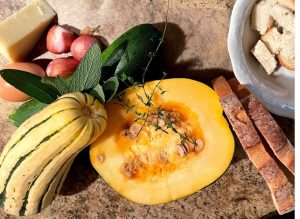 Move over pumpkin spice latte, there is a new favorite in town and it’s called winter squash. Winter squash season is upon us, a wonderful time to sing the praises of this mighty fruit, no wait, vegetable! Squash are surprisingly a fruit in the cucurbit family notably as they grow on vines and contain seeds.
Move over pumpkin spice latte, there is a new favorite in town and it’s called winter squash. Winter squash season is upon us, a wonderful time to sing the praises of this mighty fruit, no wait, vegetable! Squash are surprisingly a fruit in the cucurbit family notably as they grow on vines and contain seeds.
This time of year features many things for harvest on our farm and one of the most characteristic fall crops is winter squashes, and pumpkins belonging to that family. There are hundreds of varieties of edible squash and we enjoy growing tried and true classics along with new varieties each season. Winter squash can be stored for long periods which can help you eat healthy all winter long. This article is intended to highlight a few of the squash that are available right now so you can have fun choosing the right one for your autumn (and winter) inspired meals.
There are three groups of edible squash, Curcubita moschata, C. maxima, and C. pepe. Most of the edible squash varieties belong to the C. moschata and C. maxima species. Most inedible squash varieties belong to the C. pepo family except Delicata and Acorn squash. All too confusing? Let us simplify it for you. All winter squash grown on our farm are edible, skins and all, except Jack Be Little (aka munchkins), Gooseneck Squash, and Gourds. These inedible squash are grown for decorative purposes and are not desirable for eating.
We grow different varieties of squash on our farm annually. They include Acorn, Delicata, Spaghetti, Butternut, Honeynut, Sweet Dumpling, Carnival, Kabocha, Red Kuri, Blue Hubbard, and Turban along with an array of heirloom varieties of pumpkins which are winter squash too. Watch our video to see how many squashes you can identify from this list.
We start our squash and pumpkins from seed planted directly in the ground in late June where they will grow and mature until harvest in September through November (weather permitting). Squash and Pumpkins are fairly hardy and drought-tolerant and do not require much care. They can take about 90-120 days to mature and we pick them at maturity for sale in our markets and also open up our fields for families to enjoy the fun of picking their pumpkins fruits and vegetables in the fall. Everyone should have a memory of picking the perfect pumpkin for carving at home and enjoying roasting the seeds!
Squash is rich in vitamins and minerals along with carotenoid and beta carotene. It is a versatile fruit that can be roasted, cooked in a skillet or made into puree for use in baked goods, soups stews and other seasonal recipes. Squash can be used as a thickener and a base adding extra nutrition and flavor to any recipe. Experiment with the the various squash available on our farm to get a sense of their intricate flavors so you know which ones work best for your recipes. Miss Jenn, our culinary specialist, has curated these recipes for you. Find seasonal recipes on our website. Watch Miss Jenn show you how easy it is to roast and prepare squash in this video.
or made into puree for use in baked goods, soups stews and other seasonal recipes. Squash can be used as a thickener and a base adding extra nutrition and flavor to any recipe. Experiment with the the various squash available on our farm to get a sense of their intricate flavors so you know which ones work best for your recipes. Miss Jenn, our culinary specialist, has curated these recipes for you. Find seasonal recipes on our website. Watch Miss Jenn show you how easy it is to roast and prepare squash in this video.
Squash is one of the three ancient crops coined “The Three Sisters” which were important to indigenous people of North America. Squash, corn, and climbing beans were planted together as companion plants where the cornstalk served as a trellis for the climbing beans, and the squash provided ground cover with its dense leaves preventing water evaporation and providing weed suppression. Read more about squash on our previous blog.







